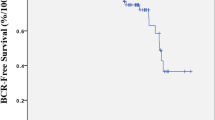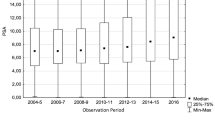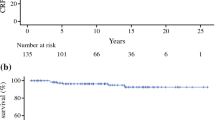Abstract
Objective
To assess the cancer control afforded by radical prostatectomy (RP) in patients with prostate-specific antigen (PSA) values above 20 ng/ml.
Methods
We performed a retrospective review of prostate cancer patients who had initial PSA values above 20 ng/ml and were treated with surgery between 1995 and 2006. Biochemical recurrence was defined as a single rise in PSA levels over 0.2 ng/ml after surgery.
Results
Overall, 41 patients were included. The mean age was 62 ± 6.43 years. The mean PSA was 27.39 ± 13.57 ng/ml (range 20.3–80). After pathological analysis, prostate cancer was organ-confined in 21 cases (51.2%) and locally advanced in 20 cases (48.8%). Positive surgical margins were detected in 36.5% of cases (n = 15). Five patients had lymph node involvement (12%). The mean prostate volume was 58 ± 28.9 cc. The mean length of follow-up after surgery was 94 ± 37 months. Median time to biochemical recurrence was 44.6 ± 22 months. The 5-year PSA-free survival rate was 53%. Through univariate analysis, the pathologic stage (p = 0.016), biopsy and pathological Gleason scores (p = 0.013; p = 0.02) and positive margin (p = 0.04) were associated with recurrence. Overall, 24 patients (58.5%) experienced a biochemical recurrence. Only margin status and pathological Gleason were significant in multivariate analysis (p < 0.05).
Conclusion
RP can be recommended as a viable primary treatment option in selected cases of the high-risk cohort of patients with pre-operative PSA values above 20 ng/ml. However, the modalities of adjuvant treatments following RP remain to be defined in patients who are likely to evolve unfavourably.


Similar content being viewed by others
References
Jemal A, Siegel R, Ward E, Hao Y, Xu J, Murray T et al (2008) Cancer statistics, 2008. CA Cancer J Clin 58:71–96. doi:10.3322/CA.2007.0010
Freedland SJ, Mangold LA, Walsh PC, Partin AW (2005) The prostatic specific antigen era is alive and well: prostatic specific antigen and biochemical progression following radical prostatectomy. J Urol 174:1276–1281. doi:10.1097/01.ju.0000173907.84852.ec
D’Amico AV, Renshaw AA, Cote K, Hurwitz M, Beard C, Loffredo M et al (2004) Impact of the percentage of positive prostate cores on prostate cancer-specific mortality for patients with low or favorable intermediate-risk disease. J Clin Oncol 22:3726–3732. doi:10.1200/JCO.2004.01.164
Partin AW, Kattan MW, Subong EN, Walsh PC, Wojno KJ, Oesterling JE et al (1997) Combination of prostate-specific antigen, clinical stage, and Gleason score to predict pathological stage of localized prostate cancer. A multi-institutional update. JAMA 277:1445–1451. doi:10.1001/jama.277.18.1445
Hull GW, Rabbani F, Abbas F, Wheeler TM, Kattan MW, Scardino PT (2002) Cancer control with radical prostatectomy alone in 1,000 consecutive patients. J Urol 167:528–534. doi:10.1016/S0022-5347(01)69079-7
Boorjian SA, Karnes RJ, Rangel LJ, Bergstralh EJ, Blute ML (2008) Mayo Clinic validation of the D’amico risk group classification for predicting survival following radical prostatectomy. J Urol 179:1354–1360. doi:10.1016/j.juro.2007.11.061
Bastide C, Kuefer R, Loeffler M, de Petriconi R, Gschwend J, Hautmann R (2006) The role of radical prostatectomy in patients with clinically localized prostate cancer and a prostate-specific antigen level > 20 ng/ml. Prostate Cancer Prostatic Dis 9:239–244. doi:10.1038/sj.pcan.4500892
Brandli DW, Koch MO, Foster RS, Bihrle R, Gardner TA (2003) Biochemical disease-free survival in patients with a high prostate-specific antigen level (20–100 ng/mL) and clinically localized prostate cancer after radical prostatectomy. BJU Int 92:19–23. doi:10.1046/j.1464-410X.2003.04269.x
O’Brien MF, Connolly SS, Kelly DG, O’Brien A, Quinlan DM, Mulvin DW (2004) Should patients with a pre-operative prostate-specific antigen greater than 15 ng/ml be offered radical prostatectomy? Ir J Med Sci 173:23–26. doi:10.1007/BF02914519
Frota R, Turna B, Santos BM, Lin YC, Gill IS, Aron M (2008) The effect of prostate weight on the outcomes of laparoscopic radical prostatectomy. BJU Int 101:589–593. doi:10.1111/j.1464-410X.2007.07263.x
Vanasupa BP, Paquette EL, Wu H, Sun L, McLeod DG, Moul JW (2002) The role of radical prostatectomy in patients with pretreatment prostate-specific antigen ≥ 40 ng/mL. Urol Oncol 7:167–172. doi:10.1016/S1078-1439(02)00187-4
Zwergel U, Suttmann H, Schroeder T, Siemer S, Wullich B, Kamradt J et al (2007) Outcome of prostate cancer patients with initial PSA ≥20 ng/ml undergoing radical prostatectomy. Eur Urol 52:1058–1065. doi:10.1016/j.eururo.2007.03.056
Gallina A, Jeldres C, Chun FK, Shariat SF, Briganti A, Walz J et al (2007) Prediction of pathological stage is inaccurate in men with PSA values above 20 ng/mL. Eur Urol 52:1374–1380. doi:10.1016/j.eururo.2006.12.010
Sanda MG, Dunn RL, Michalski J, Sandler HM, Northouse L, Hembroff L et al (2008) Quality of life and satisfaction with outcome among prostate-cancer survivors. N Engl J Med 358:1250–1261. doi:10.1056/NEJMoa074311
Bill-Axelson A, Holmberg L, Ruutu M, Haggman M, Andersson SO, Bratell S et al (2005) Radical prostatectomy versus watchful waiting in early prostate cancer. N Engl J Med 352:1977–1984. doi:10.1056/NEJMoa043739
Rozet F, Arroyo C, Cathelineau X, Barret E, Prapotnich D, Vallancien G (2004) Extraperitoneal standard laparoscopic radical prostatectomy. J Endourol 18:605–610. doi:10.1089/end.2004.18.605
Diblasio CJ, Kattan MW (2003) Use of nomograms to predict the risk of disease recurrence after definitive local therapy for prostate cancer. Urology 62(Suppl 1):9–18. doi:10.1016/j.urology.2003.09.029
Stephenson AJ, Scardino PT, Eastham JA, Bianco FJ Jr, Dotan ZA, Fearn PA et al (2006) Preoperative nomogram predicting the 10-year probability of prostate cancer recurrence after radical prostatectomy. J Natl Cancer Inst 98:715–717
Xylinas E, Drouin SJ, Comperat E, Vaessen C, Renard-Penna R, Misrai V et al (2008) Oncological control after radical prostatectomy in men with clinical T3 prostate cancer: a single-centre experience. BJU Int 103:1173–1178. doi:10.1111/j.1464-410X.2008.08208.x
Paul A, Fourmarier M, Cordonnier C, Petit J, Petit J, Saint F (2008) High PSA and total prostatectomy: specific and overall 10-year survival. Prog Urol 18:299–303. doi:10.1016/j.purol.2008.03.016
Bloch BN, Furman-Haran E, Helbich TH, Lenkinski RE, Degani H, Kratzik C et al (2007) Prostate cancer: accurate determination of extracapsular extension with high-spatial-resolution dynamic contrast-enhanced and T2-weighted MR imaging––initial results. Radiology 245:176–185. doi:10.1148/radiol.2451061502
Villers A, Puech P, Mouton D, Leroy X, Ballereau C, Lemaitre L (2006) Dynamic contrast enhanced, pelvic phased array magnetic resonance imaging of localized prostate cancer for predicting tumor volume: correlation with radical prostatectomy findings. J Urol 176:2432–2437. doi:10.1016/j.juro.2006.08.007
Conflict of interest statement
There is no conflict of interest.
Author information
Authors and Affiliations
Corresponding author
Rights and permissions
About this article
Cite this article
Nguyen, K., Eltz, S., Drouin, S.J. et al. Oncologic outcome after radical prostatectomy in men with PSA values above 20 ng/ml: a monocentric experience. World J Urol 27, 653–658 (2009). https://doi.org/10.1007/s00345-009-0419-8
Received:
Accepted:
Published:
Issue Date:
DOI: https://doi.org/10.1007/s00345-009-0419-8




